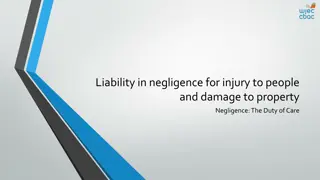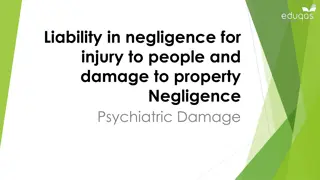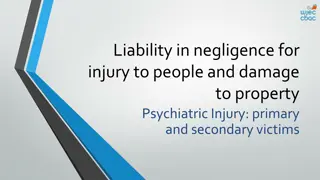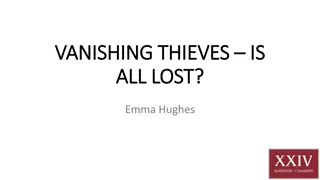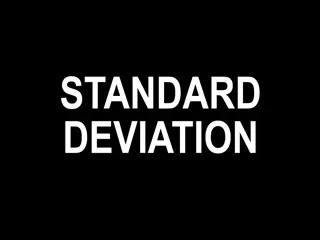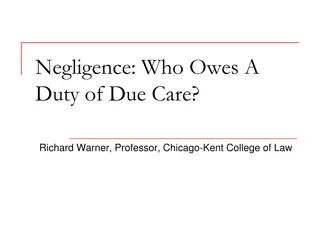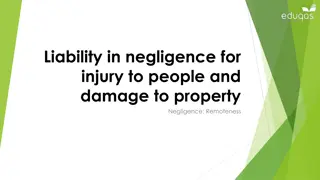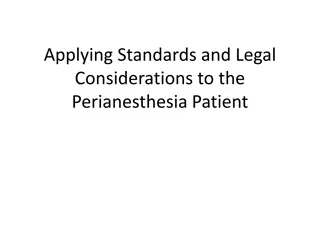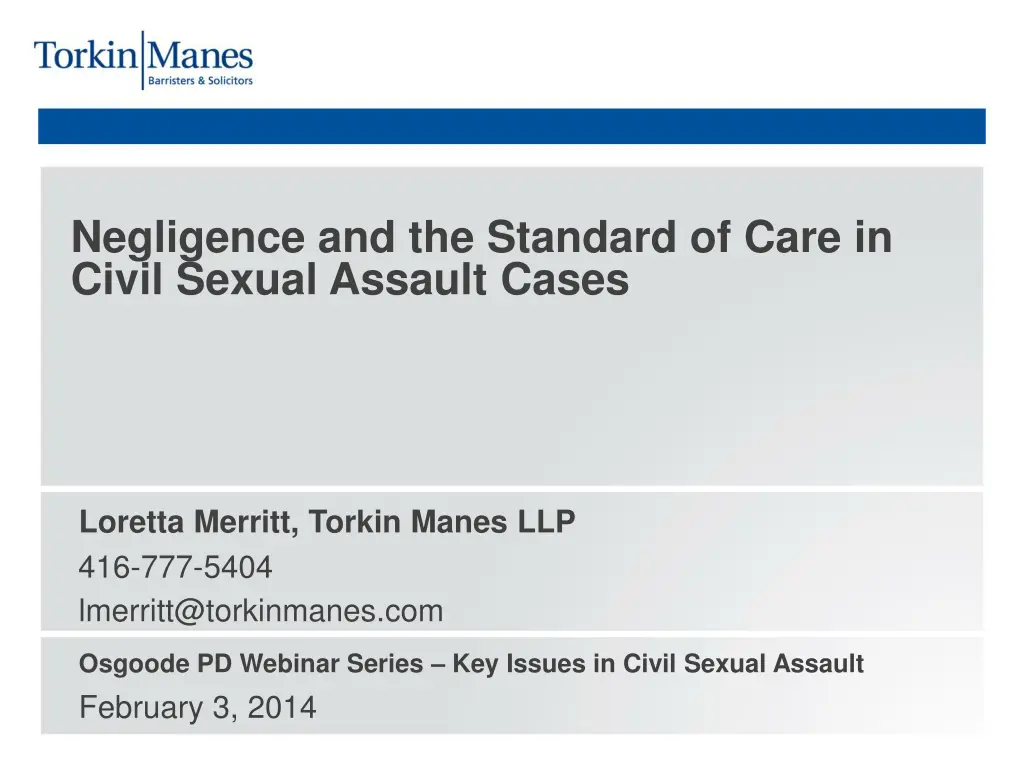
Understanding Negligence and Standard of Care in Civil Sexual Assault Cases
Explore the elements of negligence in civil sexual assault cases, including duty owed, breach of duty, and causation. Learn about establishing a duty of care, general principles regarding the standard of care, and key court decisions on negligence in such cases. Gain insights into the complexities of determining liability and negligence in instances of sexual abuse.
Download Presentation

Please find below an Image/Link to download the presentation.
The content on the website is provided AS IS for your information and personal use only. It may not be sold, licensed, or shared on other websites without obtaining consent from the author. If you encounter any issues during the download, it is possible that the publisher has removed the file from their server.
You are allowed to download the files provided on this website for personal or commercial use, subject to the condition that they are used lawfully. All files are the property of their respective owners.
The content on the website is provided AS IS for your information and personal use only. It may not be sold, licensed, or shared on other websites without obtaining consent from the author.
E N D
Presentation Transcript
Negligence and the Standard of Care in Civil Sexual Assault Cases Loretta Merritt, Torkin Manes LLP 416-777-5404 lmerritt@torkinmanes.com Osgoode PD Webinar Series Key Issues in Civil Sexual Assault February 3, 2014
Negligence 101 Three elements: 1. Duty owed (proximity and foreseeability) 2. Breach of Duty owed (falling below the standard of care) 3. Causation 2
Establishing a Duty of Care Have the courts previously recognized a prima facie duty of care If not, should a new duty of care be recognized? Foreseeability of harm and proximity of relationship. A direct relationship is an important factor in determining proximity Are there residual policy considerations that justify negating the duty? 3
General Principals Regarding the Standard of Care / Breach of Duty 1. The question is, what would a reasonable person/institution in similar circumstances do? Negligence is the doing of something a reasonable person would not do; or Negligence is the failure to do something a reasonable person would do 2. Industry standards are important but not determinative 3. Institutions are judged according to the standards of the day Date of the alleged negligence is key 4
General Principals Regarding the Standard of Care / Breach of Duty 4. Courts will consider any statutory duties 5. When did society generally become aware of the prevalence of childhood sexual assault? Not in the late 1960 s or early 1970 s (Blackwater v. Plint) In the early 1980 s police were instructed to thoroughly investigate childhood sexual abuse allegations (D.W. v. Canada) In the mid 1980 s complaints of childhood sexual abuse were prevalent (D.W. v. Canada) 5
The Chart 42 reported decisions where negligence has been discussed by the courts in civil sexual assault cases CITATION INSTITUTION YEAR(S) OF ABUSE ALLEGATIONS OF NEGLIGENCE FINDINGS OF NEGLIGENCE D.W. v. Canada (Atorney General), [1999] S.J. No. 742, 1999 SKQB 187, Maurice J. Facts: Male plaintiff sues perpetrator, William Starr, administrator of the Residence and the Crown, who was the operator of the Residence and employer of Starr. Plaintiff was a student at Gordon Student Residence. He was sexually abused on two occasions. First incident involved Starr fondling plaintiff s penis and inserting fingers in plaintiff s anus. Second incident involved Starr forcing plaintiff to perform fellatio on him. Plaintiff was between 6-9 years old at the time of assault. Held: Crown not liable based on negligence, breach of fiduciary duty, or breach of non-delegable duty. Crown was vicariously liable. Residential School 1977-1980 Reasons: No Negligence Crown was not aware of any sexual misconduct involving Starr and students until many years after he left Evaluations of Starr portrayed him as a competent administrator with the best interests of the students at heart. One staff member brought suspicions of abuse to the attention of officials, however Starr provided a credible explanation Even if the allegations had triggered an investigation, it is unlikely that the sexual misconduct would have been uncovered o the students had not complained and they looked upon Starr with awe and fear o Because of his position of power, Starr cowed the staff and students into silence At the time (late 1960's and early 1970's) society was generally unaware of the prevalence of child sexual abuse It was not until the early 1980's that the police were instructed to thoroughly investigate allegations of child sexual abuse, and it was not until 1985 that complaints of child sexual abuse became prevalent Allegations: Plaintiff alleges a number of grounds of liability on behalf of the Crown: negligence, breach of fiduciary duty, breach of non-delegable duty, and vicarious liability. Negligence: Plaintiff alleges the Crown was negligent in failing to properly evaluate, monitor, and investigate Starr, which resulted in the plaintiff being sexually abused by him. [no further details alleged]. Breach of fiduciary duty: Plaintiff argues that Crown breached its fiduciary duty to Plaintiff when it failed to prevent Starr s battery of him. Reasons: No Breach of Fiduciary Duty A breach of fiduciary duty does not lie unless the fiduciary abused his or her position of power While Starr abused his position of power over the plaintiff for personal advance, the Crown did not. 6
Analysis of the Case Law 1. Factors favouring a finding of no negligence 2. Factors favouring a finding of negligence 3. Cases dealing with institutional response to disclosure of abuse by the plaintiff 4. The negligent non-offending parent/bystander cases 7
Factors in Favour of Finding of No Negligence No actual knowledge of sexual misconduct, (D.W. v. Canada) (V.P. v. Canada) (J.L. v. Canada) (R.E.E. v. W.O.T.) Good evaluations (D.W. v. Canada) Suspicions investigated in1969 and 1971 and perpetrator provided credible explanation (D.W. v. Canada) 8
Factors in Favour of Finding of No Negligence Single incident of suspected but unproven touching does not equal a trend (A.D. v. C.D.) No causation because victims unlikely to disclose even if the abuse were investigated (D.W. v. Canada) No causation because more visits to foster home would not have resulted in a disclosure of the abuse (R.E.E. v. W.O.T.) 9
Factors in Favour of Finding of No Negligence In the early 1970 s most teachers had close relationships with students and there was no Board policy against same (K.G. v. B.W.) In the late 1970 s it was not negligent to have no programs of awareness or protection against abuse. (S.G.H. v. Gorsline) Assaults were carried out in secret and even when parents were faced with reports of abuse they could not believe abuse was a reality (Blackwater v. Plint) 10
Factors in Favour of Finding of No Negligence The plaintiff was determined to keep the relationship a secret. (A.D. v C.D.) Absence of monitoring or supervision of priests was not negligent because sexual abuse was not really on the horizon (in the late 70 s and early 80 s) (John Doe v. O Dell) 11
Factors Supporting a Finding of Negligence There is an ongoing duty to monitor and supervise children in foster care. No contact between the social worker and child after placement is negligent (M.B. v. B.C.) Negligence findings based on : No visits to a foster home for several months combined with issues concerning prior placements, double the recommended number of children and unhappiness of children not being probed by social workers. (K.L.B. v. B.C.) 12
Factors Supporting a Finding of Negligence Failure to evaluate foster father s suitability (i.e., no home study at all) combined with failure to have proper supervision where the home was in an isolated location with no telephone and inaccessible in the winter for months with evidence of only 2 visits in 14 months was found to be inadequate supervision. (J.A.K.E. v. B.C.) 13
Factors Supporting a Finding of Negligence In a group home, housing a plaintiff with a sexually aggressive roommate and failing to protect plaintiff from a known predator. (R.A.R.B. v. British Columbia) In 1976, (in child protection cases) where there were allegations of sexual abuse, steps would be taken to apprehend children or remove offenders. Failure to do so was negligent. (A.J. v. Cairnie) The standard of special diligence in placing a child is not relaxed in cases where the child is being returned to the care of their parents after removal. Home studies and criminal record checks are still required, as is ongoing supervision. (C.H. v. B.C.) 14
Factors Supporting a Finding of Negligence Failing to do a new risk assessment before removing a supervision order on a natural father in the face of child protection reports is negligent (D.M. v. R.M.) A church and Crown were found negligent for abuse in a residential school for failing to detect signs of abuse that were apparent to a reasonably prudent teacher. There were no rules of conduct for priests. The priest had students in his quarters. The children gossiped. The problem was apparent to a novice teacher at the local public school who then acted swiftly. (F.S.M. v. Clark) 15
Factors Supporting a Finding of Negligence A priest having children alone in his chambers (high frequency plus overnight visits) is not in conformance with general practice and should raise questions. The Church was treating the issue of sex as taboo, and providing no education or counselling. (J.R.S. v. Glendenning) Failing to act on prior complaints of abuse of children by a priest and taking no steps is negligent. (K.M.M. v. Darcey s of London) 16
Factors Supporting a Finding of Negligence In a jury decision: Teacher was given a key by the Superintendent of Education with no stipulations as to its use and this contravened board policy. The principal was aware the teacher preferred the company of young males Parents had expressed concerns There were homophobic slurs spray painted on the outside of the classroom and rumours The principal s determination to watch him like a hawk but do no more was negligent (S.L. v. R.T.M.) 17
Failure to Respond Appropriately After Disclosure 1. Adults in the military They moved her not him She had to stand beside him at the military trial and answer questions posed by him (with no one there from the Armed Forces to support her) They gave her the same supervisor as his common-law wife A lack of sensitivity does not equal harassment and is not sufficient to ground liability. (J.L. v. A.G. Canada) 18
Failure to Respond Appropriately After Disclosure 2. Church residential school case Doing nothing after disclosure and depriving another defendant (the crown) the opportunity to contain the physiological injury and denying the plaintiff rehabilitative measures to deal with the trauma shaming guilt was negligent. (F.F.M. v. Coarke) 3. In 1974 failing to render assistance after abuse exposed and failing to take steps to reduce its impact was negligent. (J.R.S. v. Glendenning) 19
Failure to Respond Appropriately After Disclosure 4. In 1979 (shortly after the abuse occurred) failing to attend to the needs of the plaintiff was not negligent considering the lack of knowledge at the time. (K.M.M. v. Diocese of London) 5. In 1992 after plaintiff s disclosure, the failure to provide counselling or funds combined with the Bishop s callous conduct may have aggravated the injury but was not negligent. (P.D. v. Allen) 20
Negligence of the Non-Offending Parent-Bystander 1. A parent being withdrawn and uninvolved in not sufficient to find negligence. (M.B. v. B.C.) 2. The wife of a perpetrator who abused the plaintiff was negligent where: She knew of his propensity to abuse young girls She knew of his criminal record for inappropriate sexual contact with young girls She knew of his sexual behavioural problem She was willfully blind to the abuse of the plaintiff (M.L.H. v. R.G.R.) 21
Negligence of the Non-Offending Parent-Bystander 3. The mother who failed to protect her daughter was negligent when she knew of the abuse. The fact that she was lacking in personal resources to intervene is not a sufficient defence. (K.K. v. K.W.G.) 4. The aunt to whom the plaintiff reported her abuse was negligent She gave her 12 or 13 year old niece an IUD without her knowledge in order to prevent pregnancy and hide the abuse by the uncle. (F.A.N.G.H v. Baines) 22
Conclusions 1. Are there any patterns? type of Instituion date of abuse/alleged neglience Date of decision 2. Are experts always necessary? 23
Loretta Merritt, Torkin Manes LLP 416-777-5404 lmerritt@torkinmanes.com Torkin Manes LLP 151 Yonge Street, Suite 1500 Toronto, ON M5C 2W7 www.torkinmanes.com

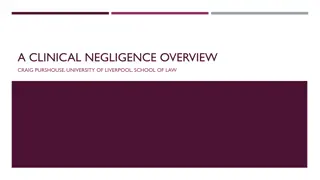
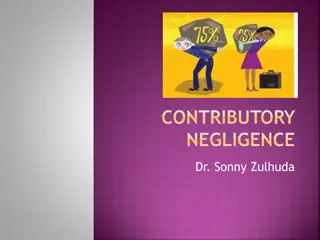
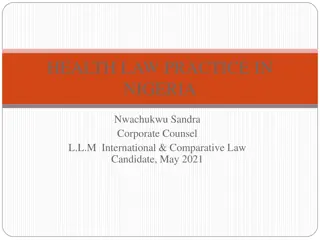



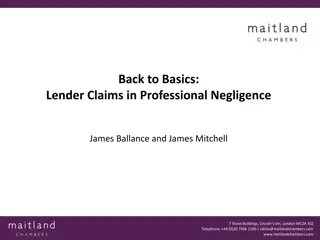
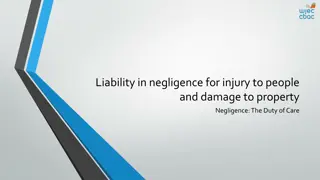
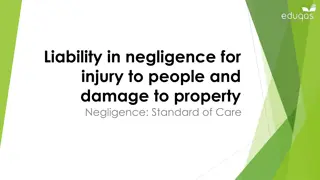



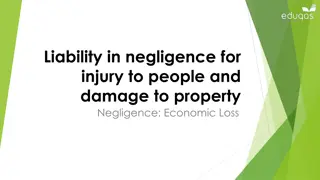
![Negligence Liability in Donoghue v. Stevenson [1932]](/thumb/198881/negligence-liability-in-donoghue-v-stevenson-1932.jpg)
